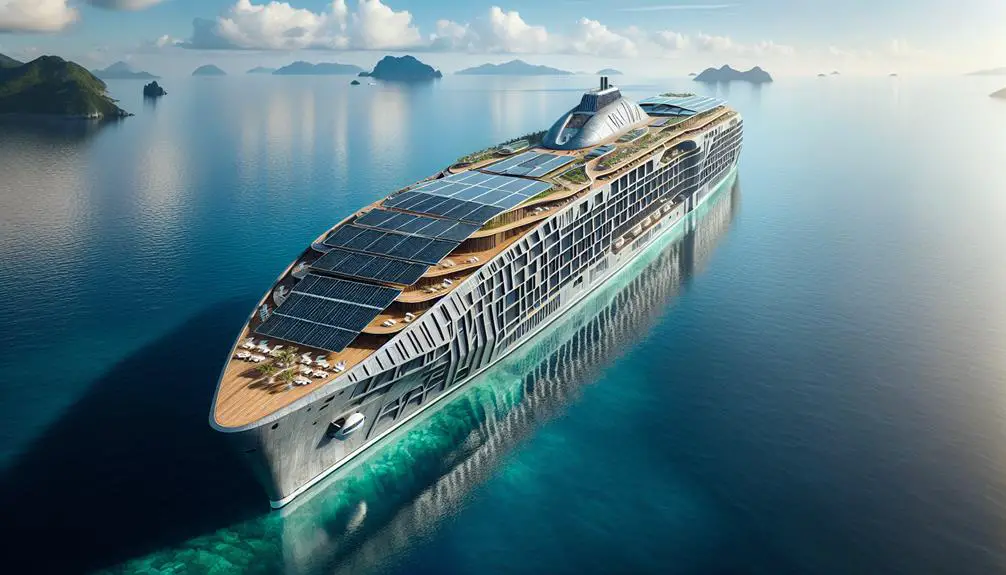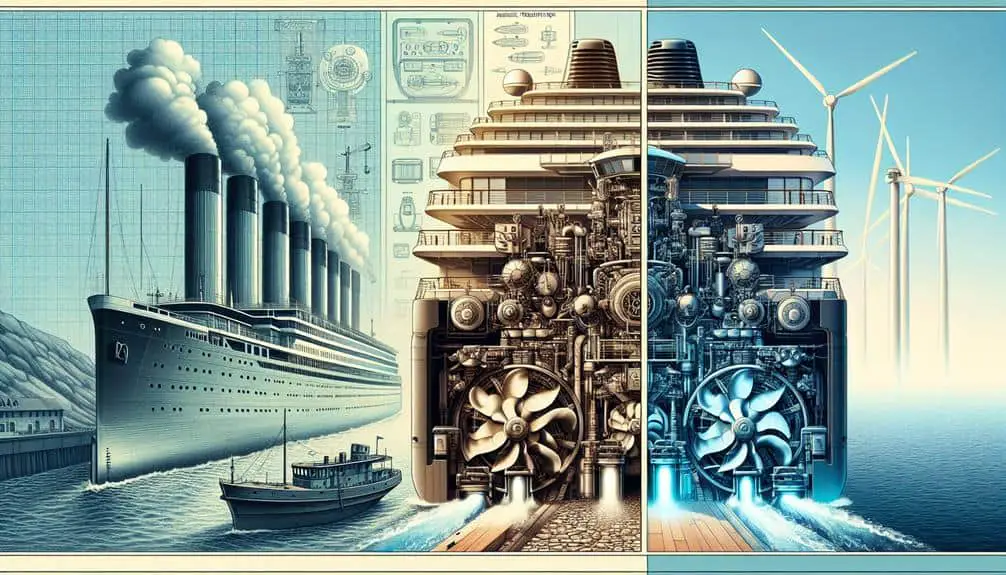Discover how bamboo's strength and flexibility, recycled steel's durability, solar panels' energy efficiency, hemp's eco-friendly properties, cork's insulation benefits, biodegradable plastics' marine life protection, and sustainable wood sourced from well-managed forests are transforming cruise ship construction with sustainability and innovation.
Key Points
- Bamboo: Sustainable, strong, and flexible for structural components.
- Recycled Steel: Durable, reduces demand for new steel, and conserves resources.
- Solar Panels: Efficiently harness solar energy for long-term cost savings.
- Hemp: Versatile, durable, and eco-friendly building material.
- Cork: Highly sustainable, renewable, and offers natural insulation properties.
Bamboo
Bamboo offers a sustainable and versatile alternative for cruise ship construction due to its strength, flexibility, and eco-friendly properties. Bamboo design in shipbuilding involves laminating multiple layers of bamboo strips to create strong and durable panels that can be used for various structural components. The eco-friendly production process of bamboo involves minimal chemical treatments, making it a more environmentally sustainable option compared to traditional shipbuilding materials.
When considering bamboo for cruise ship construction, it's essential to focus on the specific design requirements of the vessel. Engineers and architects need to carefully plan the integration of bamboo components to guarantee structural integrity and performance. Additionally, utilizing bamboo in ship construction promotes sustainable practices and reduces the overall carbon footprint of the project.
Recycled Steel
To explore another sustainable material for cruise ship construction, consider the use of recycled steel, which offers a durable and environmentally friendly alternative to traditional building materials. Steel recycling is a key component of sustainable practices in the maritime industry. By utilizing recycled steel, cruise ship builders can reduce the demand for new steel production, which has a notable environmental impact due to the energy-intensive processes involved.
Eco-friendly steel alternatives are becoming increasingly popular in construction innovation, with recycled steel leading the way. The process of recycling steel involves melting down existing steel scrap and reusing it to create new construction materials, greatly reducing the carbon footprint associated with steel production. This not only conserves natural resources but also minimizes waste generation, making it a more sustainable option for cruise ship construction.
Incorporating recycled steel into cruise ship building projects not only meets the industry's high standards for strength and durability but also aligns with the growing global focus on environmental responsibility and sustainable development.
Solar Panels
Solar panels on cruise ships are a game-changer due to their ability to harness solar energy efficiently. This sustainable solution not only reduces the ship's reliance on traditional energy sources but also provides long-term cost savings.
Additionally, the environmental impact of solar panels is minimal, making them an essential component in sustainable cruise ship construction.
Solar Energy Benefits
Harnessing the power of the sun through the use of advanced solar panel technology is a key strategy in enhancing the sustainability of cruise ship operations. Renewable energy sources like solar power offer significant advantages for cruise ships seeking to reduce their environmental impact.
Solar panels can be integrated into various parts of the ship to generate clean electricity, reducing the reliance on traditional fuel sources. The advantages of solar power include lower operating costs, decreased emissions, and a reduced carbon footprint. By utilizing solar energy, cruise ships can operate more efficiently and contribute to a greener maritime industry.
Investing in solar panels not only benefits the environment but also aligns with the growing demand for sustainable travel options.
Efficiency and Durability
Integrating advanced solar panel technology into cruise ship construction enhances operational sustainability by improving the efficiency and durability of the energy generation system. When contemplating solar panels for cruise ships, the focus is on maximizing energy efficiency and guaranteeing long-term durability.
Here are key aspects to ponder:
- High Efficiency Rates: Utilizing cutting-edge solar panel designs to maximize energy conversion.
- Robust Construction: Implementing durable materials to withstand harsh marine environments.
- Maintenance Optimization: Incorporating features that facilitate easy maintenance and upkeep.
- Enhanced Performance Monitoring: Installing systems for real-time tracking to ensure peak energy production.
Environmental Impact
When evaluating the environmental impact of solar panels in cruise ship construction, it's essential to assess their potential benefits and drawbacks in relation to sustainability goals.
Solar panels, as renewable energy sources, hold significant promise for reducing the carbon footprint of cruise ships. By harnessing the power of the sun, these panels can generate clean electricity onboard, decreasing reliance on traditional fuel sources. This shift not only minimizes harmful emissions but also contributes to long-term cost savings and operational efficiency.
However, challenges such as space constraints and initial installation costs must be carefully considered. Innovative design solutions and advancements in solar technology are continuously improving the efficiency and feasibility of integrating solar panels into cruise ship construction, making them an increasingly attractive option for environmentally-conscious fleets.
Hemp
Hemp, a versatile and eco-friendly material, is being increasingly utilized in cruise ship construction for its sustainable properties and durability. Hemp offers various benefits that make it an excellent choice for building cruise ships:
- Hemp Insulation: Hemp fibers can be processed into insulation material that isn't only environmentally friendly but also provides excellent thermal and acoustic insulation for cruise ship cabins, reducing energy consumption for heating and cooling.
- Sustainable Building Materials: Hemp can be used in various forms, including hempcrete, which is a mixture of hemp fibers, lime, and water. This sustainable building material is lightweight, fire-resistant, and has excellent thermal properties, making it ideal for constructing cruise ship interiors.
- Durability: Hemp fibers are incredibly strong and resistant to wear and tear, making them suitable for use in various structural components of cruise ships, such as walls, floors, and ceilings.
- Renewable Resource: Hemp is a fast-growing plant that requires minimal water and no pesticides, making it a renewable and environmentally friendly resource for cruise ship construction.
Cork
Cork, known for its eco-friendly benefits, is a highly sustainable material that's being increasingly utilized in cruise ship construction. The durability of cork makes it an ideal choice for various components in shipbuilding, providing strength and resilience while also being lightweight.
Considered a renewable resource, cork aligns with the sustainability goals of the maritime industry, offering a promising solution for creating more environmentally conscious cruise ships.
Corks Eco-Friendly Benefits
Utilizing cork in cruise ship construction offers a myriad of eco-friendly benefits that contribute to sustainability and environmental conservation efforts. Cork insulation and eco-friendly flooring are just a couple of the ways in which cork can enhance the eco-credentials of cruise ships.
Here are four key eco-friendly benefits of incorporating cork into cruise ship construction:
- *Natural Insulation:* Cork's cellular structure provides excellent thermal and acoustic insulation properties, reducing the energy needed for heating and cooling systems.
- *Renewable Resource:* Cork is harvested from the bark of cork oak trees, which can be done without harming the tree, making it a sustainable and renewable material.
- *Carbon Sequestration:* Cork oak trees store CO2 in their bark, contributing to carbon sequestration and helping combat climate change.
- *Biodegradability:* Cork is biodegradable, ensuring that once its lifespan is over, it can naturally decompose without leaving harmful residues in the environment.
Durability of Cork
When considering the sustainability and eco-friendly benefits of cork in cruise ship construction, a crucial aspect to examine is the durability of cork material. Cork's durability stems from its cellular structure, which allows it to withstand high levels of impact and pressure without deforming.
This resilience makes cork an ideal choice for insulation in cruise ships, as it can maintain its integrity even in challenging maritime environments. Additionally, cork's natural elasticity enables it to absorb vibrations and noises, enhancing the overall comfort and safety of passengers.
Regarding sustainable flooring, cork's durability guarantees that it can withstand heavy foot traffic and resist wear and tear over time, making it a long-lasting and environmentally friendly option for cruise ship interiors.
Biodegradable Plastics
Biodegradable plastics offer a sustainable alternative in cruise ship construction, aligning with environmentally conscious practices and reducing the industry's ecological footprint. These innovative materials provide a solution to the environmental challenges posed by traditional plastics.
- Compostable Alternatives: Biodegradable plastics break down into natural components that can be composted, reducing the volume of waste generated during the ship's lifecycle.
- Sustainability in Production: The manufacturing process of biodegradable plastics often involves renewable resources, minimizing the reliance on fossil fuels and contributing to a more sustainable production chain.
- Marine Life Protection: By using biodegradable plastics, cruise ships can help protect marine life by reducing the amount of plastic waste that ends up in oceans, preserving delicate ecosystems.
- Reducing Plastic Waste in Oceans: Choosing biodegradable plastics for various applications onboard can significantly decrease the pollution caused by traditional plastics, supporting efforts to clean and restore ocean environments.
Sustainable Wood
Incorporating sustainably sourced wood in cruise ship construction enhances environmental stewardship and promotes long-term ecological balance within the maritime industry. Sustainable wood derives from well-managed forests, ensuring the longevity of wood resources. The use of sustainable forestry practices guarantees that for every tree harvested, another is planted, maintaining the forest ecosystem's health and diversity.
Wood possesses remarkable carbon sequestration properties, actively removing carbon dioxide from the atmosphere and storing it within its fibers. This quality makes sustainable wood a valuable ally in combating climate change, as it aids in reducing greenhouse gas emissions. Additionally, sustainable forestry practices not only protect natural habitats but also support local communities by providing employment opportunities and fostering economic growth.
When considering materials for cruise ship construction, opting for sustainable wood not only contributes to the vessel's structural integrity but also aligns with environmentally conscious choices. By prioritizing sustainable wood, cruise ship builders can demonstrate a commitment to responsible resource management and environmental preservation.
Frequently Asked Questions
Are There Any Specific Certifications or Standards That Cruise Ship Builders Must Adhere to When Using Sustainable Materials Like Bamboo or Hemp?
When using sustainable materials like bamboo or hemp in cruise ship construction, make sure adherence to certifications such as FSC, guaranteeing responsible sourcing. Consider environmental impact throughout the process to meet standards and regulations for sustainable practices.
How Do Cruise Ship Companies Ensure That the Recycled Steel Used in Construction Meets Safety and Durability Requirements?
To guarantee that recycled steel meets safety standards and durability requirements for cruise ship construction, companies conduct rigorous testing, inspections, and quality control measures throughout the manufacturing process. This ensures compliance with industry regulations and high-quality performance.
What Are the Challenges or Limitations in Incorporating Solar Panels on Cruise Ships, and How Are These Addressed During the Construction Process?
Incorporating solar panels on cruise ships presents challenges in weight distribution and space utilization. Solutions involve advanced structural design to optimize placement, ensuring efficient energy production while maintaining the vessel's stability and aesthetics.
Are There Any Regulations or Guidelines in Place for the Use of Biodegradable Plastics on Cruise Ships, and How Does This Impact the Overall Sustainability of the Vessel?
When considering regulations for biodegradable plastics on cruise ships, guidelines play a pivotal role in determining sustainability impact. Adhering to these rules guarantees that vessel construction aligns with eco-friendly practices, promoting a greener future for the maritime industry.
How Do Cruise Ship Builders Ensure That Sustainable Wood Used in Construction Is Sourced Responsibly and Does Not Contribute to Deforestation?
To guarantee sustainable wood is responsibly sourced without contributing to deforestation, cruise ship builders meticulously scrutinize suppliers' certifications, traceability systems, and forest management practices. By prioritizing responsible sourcing, they mitigate environmental harm and support forest preservation.




